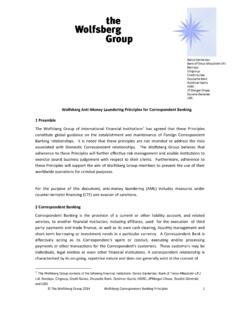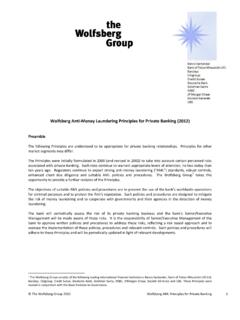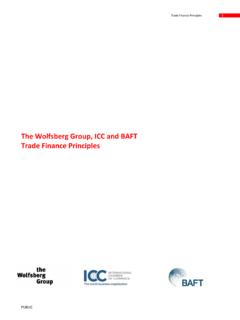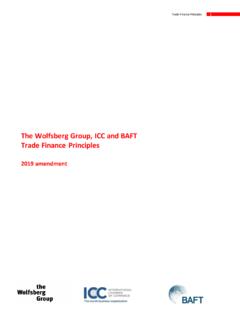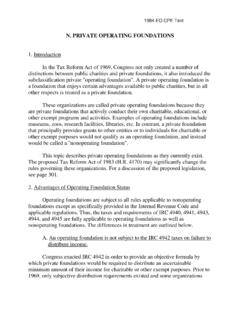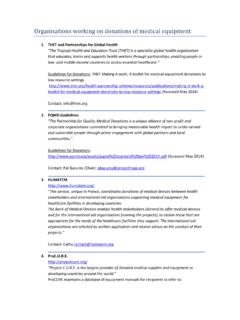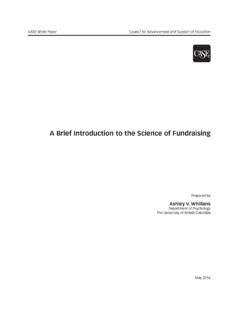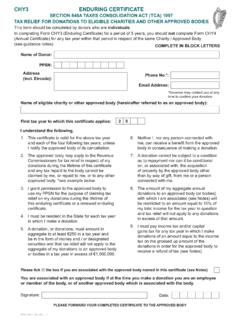Transcription of Wolfsberg Group Principles On A Risk Based Approach For ...
1 Wolfsberg Statement Guidance on a Risk Based Approach for Managing money Laundering Risks Preamble The continuing threat of money laundering through financial institutions is most effectively managed by understanding and addressing the potential money laundering risks associated with customers and transactions. Therefore, the Wolfsberg Group 1 has developed this Guidance to assist institutions in managing money laundering risks and further the goal of Wolfsberg Group members to endeavour to prevent the use of their institutions for criminal purposes. It is well understood that money launderers go to great lengths to make their transactions indistinguishable from legitimate transactions. Accordingly, it is difficult (at times impossible) for an institution to distinguish between legal and illegal transactions, notwithstanding the development and implementation of a reasonably designed risk Based Approach in an institution's anti- money laundering program.
2 An assessment of money laundering risks will result in the application of appropriate due diligence when entering into a relationship, and ongoing due diligence and monitoring of transactions throughout the course of the relationship. A reasonably designed risk Based Approach will provide a framework for identifying the degree of potential money laundering risks associated with customers and transactions and allow for an institution to focus on those customers and transactions that potentially pose the greatest risk of money laundering. The Wolfsberg Group believes that this Guidance will support risk management and assist institutions in exercising business judgement with respect to their clients. There is no universally 1. The Wolfsberg Group consists of the following leading international financial institutions: ABN AMRO, Banco Santander, Bank of Tokyo-Mitsubishi-UFJ, Barclays, Citigroup, Credit Suisse, Deutsche Bank, Goldman Sachs, HSBC, JP.
3 Morgan Chase, Soci t G n rale, and UBS. In addition, Allied Irish Banks, DBS, Lloyds, TSB, SEB and Standard Chartered Bank participated in the development of this Guidance. The Wolfsberg Group 2006 Wolfsberg Risk- Based Approach Guidance 1. agreed and accepted methodology by either governments or institutions, which prescribes the nature and extent of a risk Based Approach . Accordingly, this Guidance seeks to articulate relevant considerations which institutions may find useful in developing and implementing a reasonably designed risk Based Approach . The specifics of an institution's particular risk Based process should be determined by each institution Based on the operations of that institution. This Guidance is not designed to prohibit potential customers from engaging in transactions with institutions, but rather assist institutions in effectively managing potential money laundering risks.
4 1. Basis of a Reasonably Designed Risk Based Approach A reasonably designed risk Based Approach is one by which institutions identify the criteria to measure potential money laundering risks. Identification of the money laundering risks of customers and transactions will allow institutions to determine and implement proportionate measures and controls to mitigate these risks. Risks for some customers may only become evident once the customer has begun transacting through the account, making monitoring of customer transactions a fundamental component of a risk Based Approach . money laundering risks may be measured using various categories, which may be modified by risk variables. The most commonly used risk criteria are: Country risk;. Customer risk; and Services risk in each case as modified by the risk variables as described below. The weight given to these risk categories (individually or in combination) in assessing the overall risk of potential money laundering is discretionary with each institution.
5 There clearly is not one single methodology to apply to these risk categories, and the application of these risk categories is intended to provide a strategy for managing potential money laundering risks associated with potentially high risk customers. Each financial institution should document and periodically review its risk assessment Approach . 2. Applicability to Existing Customers A financial institution may consider whether a risk assessment should be carried out in respect of existing customers. Circumstances may exist where a financial institution is satisfied with its existing risk control measures for particular customers as a result of which additional risk assessment may be unnecessary. Any decision in this regard should be taken in the context of the overall risks of the institution's business or events with respect to particular customers, transactions or business lines that become apparent through monitoring of transactions or that otherwise become known that may suggest a new risk assessment of the particular customer is appropriate.
6 The Wolfsberg Group 2006 Wolfsberg Risk- Based Approach Guidance 2. 3. Risk Variables Some degree of judgement is involved in determining the level of risk a particular client represents to an institution. An institution's risk Based Approach methodology may therefore also take into account additional risk variables, specific to any particular customer or transaction. These variables may increase or decrease the perceived risk posed by a particular customer or transaction and may include: The level of assets to be deposited by the particular customer or size of transactions undertaken. For example, unusually high levels of assets or unusually large transactions compared to what might reasonably be expected of customers with a similar profile may mean that customers not otherwise seen as higher risk should be treated as such. Conversely, low levels of assets or low value transactions involving customers that would otherwise appear to be higher risk mean that a financial institution may decide to treat such customers as lower risk within an overall risk Based Approach .
7 The level of regulation or other oversight or governance regime to which a customer is subject. A customer that is a financial institution, for example, regulated in a jurisdiction recognised as having adequate Anti- money Laundering ('AML') standards (or is part of a Group that implements a Group standard where the parent is subject to adequate AML. regulation and supervision and the parent of the customer exercises appropriate oversight over the customer) poses less risk from a money laundering perspective than a customer that is unregulated or subject only to minimal AML regulation. Additionally companies and their wholly owned subsidiaries that are publicly owned and traded on a recognized exchange pose minimal money laundering risks. Even though it may become substantially more difficult to distinguish between legitimate and illegitimate transactions, these companies are usually from jurisdictions with an adequate, recognised regulatory scheme, and therefore, generally pose less risk due to the type of business they conduct and the wider governance regime to which they are subject.
8 In addition, the necessity to have a specific understanding of each of the transactions conducted by these companies is mitigated by the nature of the company (publicly owned and traded from jurisdictions with adequate controls). Moreover, these entities may not need to be subjected to as stringent account opening due diligence or transaction monitoring during the course of the relationship. The regularity or duration of the relationship. Long standing relationships involving frequent client contact throughout the relationship may present less risk from a money laundering perspective. The familiarity with a jurisdiction, including knowledge of local laws, regulations and rules, as well as the structure and extent of regulatory oversight, as the result of an institution's own operations within the jurisdiction. Greater familiarity will enhance the ability of the institution to assess the client.
9 The use by clients of intermediate corporate vehicles or other structures that have no clear commercial or other rationale or that unnecessarily increase the complexity or otherwise result in a lack of transparency for the financial institution. Such vehicles or structures will The Wolfsberg Group 2006 Wolfsberg Risk- Based Approach Guidance 3. increase the risk unless the rationale is understood and the structure is sufficiently transparent to the institution. 4. Measures and Controls for Higher Risk Situations Financial institutions should design and implement appropriate measures and controls to mitigate the potential money laundering risks of those customers that are determined to be higher risk as the result of the institution's risk assessment process. Such measures and controls may require investment both in terms of resource and time in order to identify and capture appropriate customer risk data.
10 These measures and controls may include one or more of the following: Increased awareness by the institution of higher risk situations within business lines across the institution;. Increased levels of know your customer ( KYC ) or enhanced due diligence;. Escalation for approval of the establishment of an account or relationship;. Increased monitoring of transactions; and Increased levels of ongoing controls and reviews of relationships. The same measures and controls may often address more than one of the risk criteria identified, and it is not necessarily expected that an institution establish specific controls targeting each and every risk criterion set forth in this Guidance. Wolfsberg Group guidelines and Principles provide more detailed guidance on appropriate enhanced measures and controls that could be initiated for higher risk customers. 2. 5. Country Risk Country risk, in conjunction with other risk factors, provides useful information as to potential money laundering risks.
